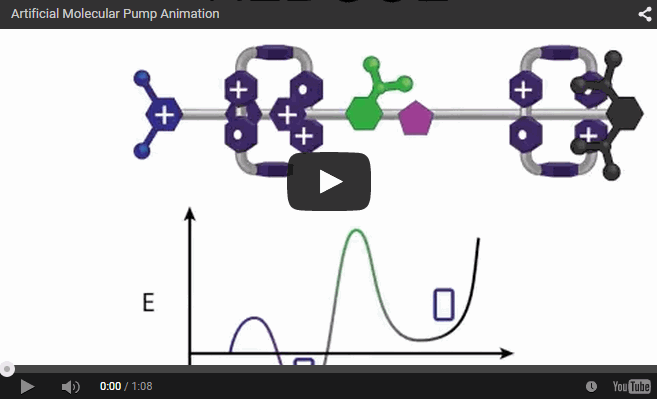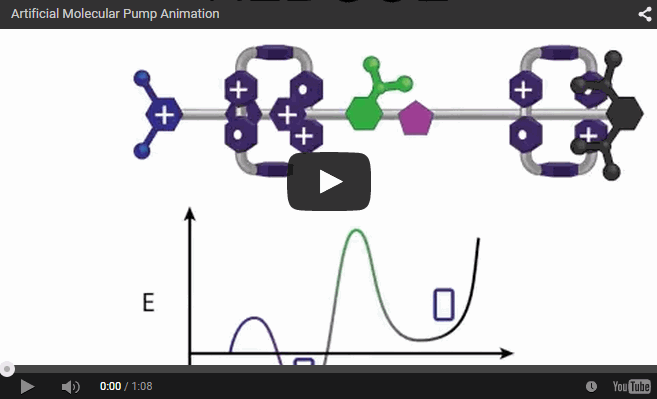
Design mimics pumping mechanism of life-sustaining proteins found in living cells
Using nature for inspiration, a team of Northwestern University scientists is the first to develop an entirely artificial molecular pump, in which molecules pump other molecules. This tiny machine is no small feat. The pump one day might be used to power other molecular machines, such as artificial muscles.
The new machine mimics the pumping mechanism of life-sustaining proteins that move small molecules around living cells to metabolize and store energy from food. For its food, the artificial pump draws power from chemical reactions, driving molecules step-by-step from a low-energy state to a high-energy state — far away from equilibrium.
While nature has had billions of years to perfect its complex molecular machinery, modern science is only beginning to scratch the surface of what might be possible in tomorrow’s world.
“Our molecular pump is radical chemistry — an ingenious way of transferring energy from molecule to molecule, the way nature does,” said Sir Fraser Stoddart, the senior author of the study. Stoddart is the Board of Trustees Professor of Chemistry in Northwestern’s Weinberg College of Arts and Sciences.
“All living organisms, including humans, must continuously transport and redistribute molecules around their cells, using vital carrier proteins,” he said. “We are trying to recreate the actions of these proteins using relatively simple small molecules we make in the laboratory.”
Details of the artificial molecular pump were published May 18 by the journal Nature Nanotechnology.
Chuyang Cheng, a fourth-year graduate student in Stoddart’s laboratory and first author of the paper, has spent his Ph.D. studies researching molecules that mimic nature’s biochemical machinery. He first designed an artificial pump two years ago, but it required more than a year of testing prototypes before he found the ideal chemical structure.
“In some respects, we are asking the molecules to behave in a way that they would not do normally,” Cheng said. “It is much like trying to push two magnets together. The ring-shaped molecules we work with repel one another under normal circumstances. The artificial pump is able to syphon off some of the energy that changes hands during a chemical reaction and uses it to push the rings together.”
The tiny molecular machine threads the rings around a nanoscopic chain — a sort of axle — and squeezes the rings together, with only a few nanometers separating them. At present, the artificial molecular pump is able to force only two rings together, but the researchers believe it won’t be long before they can extend its operation to tens of rings and store more energy.
Stoddart’s team has been researching artificial molecular machines for several years. A challenge they have faced for a long time is how to power their machines. This latest advance may allow them to make machines that perform tasks at the molecular level.
Compared to nature’s system, the artificial pump is very simple, but it is a start, the researchers say. They have designed a novel system, using kinetic barriers, that allows molecules to flow “uphill” energetically.
“This is non-equilibrium chemistry, moving molecules far away from their minimum energy state, which is essential to life,” said Paul R. McGonigal, an author of the study. “Conducting non-equilibrium chemistry in this way, with simple artificial molecules, is one of the major challenges for science in the 21st century.”
Read more: NATURE INSPIRES FIRST ARTIFICIAL MOLECULAR PUMP
The Latest on: Molecular Pump
[google_news title=”” keyword=”Molecular Pump” num_posts=”10″ blurb_length=”0″ show_thumb=”left”]
via Google News
The Latest on: Molecular Pump
- A Massive Study Is Revealing Why Exercise Is So Good for Our Healthon May 6, 2024 at 12:30 pm
Rather than focusing on single proteins or genes related to exercise, the project takes a Google Earth approach—let’s see the overall picture.
- Attosecond core-level spectroscopy reveals real-time molecular dynamicson May 6, 2024 at 8:44 am
Chemical reactions are complex mechanisms. Many different dynamic processes are involved, affecting both the electrons and the nucleus of the present atoms. Very often, the strongly coupled electron ...
- Top 8 Best Pump Supplements in 2024on April 29, 2024 at 5:00 pm
The effectiveness of your training can be significantly improved with a good pump supplement. These supplements aim to increase blood circulation to your muscles, possibly improving endurance ...
- Pump-probe high-harmonic spectroscopy could catch geometric phase effect around conical intersection in molecule: Studyon April 29, 2024 at 1:52 pm
A collaborative research team from Nanjing University of Science and Technology (NJUST) and East China Normal University (ECNU) has theoretically proposed that a pump-probe high-harmonic spectroscopy ...
- Molecular biologyon April 22, 2024 at 4:59 pm
Molecular biology is concerned with understanding processes in living organisms at a molecular level, as well as the chemical and physical structure of macromolecules. Molecular biologists focus on ...
- Which Size Heat Pump Is Right for Your Home?on April 21, 2024 at 7:45 am
Erin Gobler is a personal finance writer based in Madison, Wisconsin. She writes about topics including budgeting, student loans, credit, mortgages, investing and insurance. Her work has been ...
- How Much Does Well Pump Installation And Replacement Cost In 2024?on April 13, 2024 at 5:44 pm
Commissions do not affect our editors' opinions or evaluations. Replacing a well pump may be more affordable than buying a new one out-right due to the fact that some well pumps can be upgraded ...
- Why Heat Pumps Are the Future, and How Your Home Could Use Oneon April 13, 2024 at 5:00 pm
Here’s why. By Hilary Howard Heat pumps, which both warm and cool buildings and are powered by electricity, have been touted as the answer to curbing greenhouse gas emissions produced by homes ...
- Molecular Omicson April 9, 2024 at 2:23 pm
The guide will also help if for any reason you have difficulty accessing the content you want. Molecular Omics publishes high-quality research in the -omics sciences. We welcome scientific research ...
via Bing News










